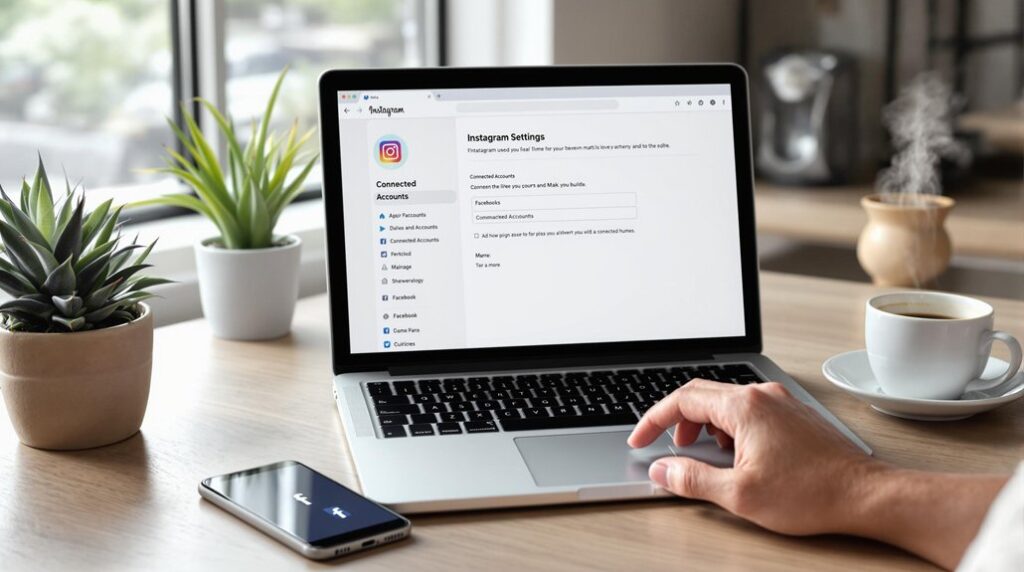To enhance retargeting with Facebook Ads, start by installing the Facebook Pixel to track user actions on your site. Create custom audiences based on behaviors like abandoned carts or page visits. Use dynamic ads to show relevant products to these users, boosting conversions by 70%. Tailor your ad messaging to match user segments, and employ social proof like customer testimonials to build trust. Monitor key metrics such as CTR and conversion rate to optimize your budget and improve ROI. For more advanced strategies and tips, keep exploring to amplify your marketing game even further.
Key Takeaways
- Utilize Facebook Pixel to track user behavior and create custom audiences for precise retargeting.
- Implement dynamic ads to show personalized product recommendations based on user interactions.
- Sync your CRM data with Custom Audiences to enhance targeting precision.
- Experiment with ad formats and messaging to find the most effective combination for different audience segments.
- Regularly monitor and adjust budget allocation based on key performance metrics to maximize ROI.
Understanding Facebook Retargeting
Understanding Facebook retargeting is essential for leveraging data-driven strategies to re-engage your website visitors and drive conversions. By using the Facebook Pixel, you can track user behavior on your site and create custom audiences for retargeting. This pixel is vital because it collects valuable data, allowing you to segment and target users based on their specific actions, such as abandoned carts or page views.
To maximize retargeting effectiveness, you need to understand the various targeting options available. Custom audiences enable you to tailor your ads to specific user behaviors, ensuring your messaging is relevant and timely. For example, you can set up campaigns targeting users who visited a product page but didn't complete a purchase. This targeted approach makes your ads more compelling, increasing the likelihood of conversion.
Additionally, you can utilize dynamic ads, which automatically show relevant products to users based on their site activity. This level of personalization greatly boosts the impact of your retargeting efforts.
Benefits of Facebook Retargeting
Harnessing Facebook retargeting can greatly enhance your marketing strategy by focusing on users who have already demonstrated interest in your products, thereby increasing the likelihood of conversions and maximizing ROI. By targeting these warm leads, you're not only driving increased engagement but also ensuring your outreach is more effective and strategic.
Retargeting on Facebook allows you to build custom audiences, honing in on users who have shown passive to high purchase intent. This targeted outreach makes it easier to guide potential customers through the sales funnel, leading to improved conversion rates. Additionally, retargeting boosts brand awareness and builds trust, as repeated exposure to your ads reinforces your brand's presence in the consumer's mind.
Below is a table that encapsulates the emotional benefits of Facebook retargeting:
| Benefit | Emotional Impact |
|---|---|
| Increased Engagement | Feels valued and recognized |
| Targeted Outreach | More relevant ad exposure |
| Improved Conversion | Satisfaction of completion |
| Boosted Brand Awareness | Familiarity and trust |
| Enhanced ROI | Financial security |
These benefits collectively enhance revenue generation by focusing your marketing efforts on individuals most likely to convert. Embracing Facebook retargeting isn't just a tactic; it's a strategic move to capitalize on existing interest and drive meaningful results.
Setting Up Your Campaign
To establish your successful Facebook retargeting campaign, begin by installing the Facebook pixel on your website to meticulously track user actions and behaviors. This pixel tracking is crucial for creating custom audiences, allowing you to segment users based on specific actions like page views or add-to-cart events.
Next, determine your campaign objectives. Align your goals with the desired outcomes, whether it's increasing awareness, driving traffic, boosting engagement, generating leads, or promoting an app. Your objectives will guide your strategy and help you focus on the right metrics.
Select the right ad placements to effectively reach your target audience. Consider devices, platforms, and locations to make sure your ads appear where your audience is most active. This strategic placement maximizes exposure and engagement.
For effective campaign optimization, consistently track performance metrics. Pay attention to:
- Website Clicks: Measure how effectively your ads are driving traffic.
- CTR (Click-Through Rate): Assess the relevance and appeal of your ads.
- CPC (Cost Per Click): Optimize your budget by monitoring costs.
Facebook Retargeting Tips
Leverage meta pixel integration to precisely retarget users based on their online behaviors, ensuring your ads reach those most likely to convert. By tracking user actions, you can segment your audience effectively, from those who merely visited your site to those who added items to their cart but didn't complete the purchase. This granular approach helps improve your retargeting metrics, giving you a clearer view of which segments yield the highest ROI.
Experiment with various ad formats and messaging to see what resonates best with different audience segments. Dynamic ads can automatically show the right products to the right audience based on their previous interactions. This level of ad optimization is essential for enhancing engagement and conversion rates.
Don't forget to employ quality assurance techniques. Featuring customer quotes and highlighting your unique selling propositions can greatly boost your ads' credibility. Social proof, such as customer testimonials, reassures potential buyers and reminds them of the value your brand offers.
Advanced Retargeting Strategies
Advanced retargeting strategies can greatly enhance your ad campaign's effectiveness by targeting users based on their specific behaviors and engagement levels. By focusing on advanced targeting strategies, you can leverage behavioral segmentation to make sure your ads reach the right audience at the right time.
One powerful approach involves dynamic ads. These ads automatically show personalized products based on user behavior and interests, which can notably increase conversion rates.
Another critical method is syncing Custom Audiences with your CRM data. This allows for precise targeting and ad personalization, driving higher engagement and conversion rates.
To further enhance your campaign, consider these advanced techniques:
- Retargeting video ads: Use engaging videos to capture attention and drive conversions.
- Behavioral segmentation: Target users who've performed specific actions like product views, add to cart actions, or site visits.
- Creative optimization: Experiment with different ad formats and messaging to find the most effective combinations.
Best Practices for Success
To maximize your retargeting success, start by testing various high-value audience segments to identify the most responsive groups.
Craft engaging ad creatives that speak directly to your audience's needs, and leverage dynamic remarketing to deliver personalized content.
Track conversions meticulously to refine your strategies and guarantee peak performance.
Audience Segmentation Techniques
When you segment your audience based on behavior, demographics, and interactions, you create highly personalized ad campaigns that drive better engagement and conversions. Using behavioral targeting and demographic segmentation, you can tailor your ads to different audience needs and interests effectively. By leveraging Facebook's Custom Audiences, you can target specific groups like website visitors, email subscribers, or app users, guaranteeing your ad spend is used efficiently.
To maximize your efforts, consider the following techniques:
- Behavioral Targeting: Use data on past behaviors such as previous website visits or purchase history to create segments that receive relevant, personalized messaging.
- Demographic Segmentation: Group your audience by age, gender, location, or income level to deliver ads that resonate with their unique demographic characteristics.
- Interaction-Based Audiences: Create segments based on how users interact with your content, such as likes, shares, and comments, to engage them with tailored messaging.
Utilize dynamic ads to automatically show the most relevant products or content to these segmented audiences.
Continuously analyze and optimize your audience segments based on performance metrics like click-through rates and conversion rates to improve ad effectiveness. This strategic approach ensures you're always delivering the right message to the right audience at the right time.
Creative Ad Design
Incorporating eye-catching visuals and compelling copy in your Facebook ads is essential for capturing audience attention and driving engagement. Visual storytelling plays a pivotal role in making your ads memorable. Use high-quality images and videos that resonate with your audience's emotions and interests. Your brand messaging should be clear and consistent across all visuals to strengthen brand recognition.
Vital CTAs (Call-to-Actions) are important to prompt specific actions from your viewers, whether it's clicking, signing up, or making a purchase. Craft CTAs that are direct and action-oriented to drive desired conversions.
Don't overlook the importance of designing mobile-friendly ads. With a significant portion of Facebook users accessing the platform via mobile devices, make sure your design elements and copy are easily viewable and engaging on smaller screens.
Testing different ad formats and creative elements is essential to identify what resonates best with your target audience. A/B testing can help you refine your approach based on performance data.
Leverage retargeting data to personalize ad content. Tailor your brand messaging to align with the specific interests or behaviors of your audience, resulting in higher engagement rates and better overall ad performance.
Conversion Tracking Methods
Accurate conversion tracking is essential for maximizing the ROI of your Facebook ad campaigns and ensuring your marketing efforts are truly effective. To achieve this, start by implementing the Facebook Pixel to monitor user actions on your website. This tool allows you to track standard events and set up custom conversions to capture specific actions like purchases, sign-ups, or page views, enhancing your tracking accuracy.
Next, use UTM parameters in your URLs to track ad performance. These parameters help attribute conversions to specific ads or campaigns, supporting more precise attribution modeling. By understanding which ads drive the most conversions, you can make informed decisions about budget allocation and conversion optimization.
Additionally, leverage Facebook Analytics to gain valuable audience insights. This platform provides detailed data on user behavior, conversion paths, and overall campaign ROI. By analyzing this data, you can fine-tune your strategies and improve your ad performance.
Implement the Facebook Pixel for accurate tracking.
Use UTM parameters to attribute conversions.
Leverage Facebook Analytics for audience insights.
Monitoring and Adjusting Campaigns
To maximize your Facebook retargeting campaigns, focus on analyzing key performance metrics like CTR, conversion rate, and ROAS.
Adjust your budget allocation based on this data to make sure you're spending efficiently and targeting the right audience segments.
Analyzing Performance Metrics
By closely monitoring key metrics like CTR, conversion rate, and ROAS, you can make data-driven adjustments to optimize your Facebook ad campaigns. Performance analysis is vital to understanding how well your ads resonate with your audience. Keeping a close eye on these metrics helps you gauge audience engagement and identify areas for conversion optimization.
Using Facebook Ads Manager, you can track various performance indicators to refine your retargeting strategies. Ad effectiveness can be measured by analyzing data such as:
- Ad frequency: Making sure your audience isn't experiencing ad fatigue.
- Engagement rates: Assessing likes, shares, and comments to measure interest.
- Conversions: Tracking the number of desired actions taken by users.
A/B testing different ad variations is another effective way to identify the most impactful messaging and visuals. For instance, testing different headlines, images, and call-to-actions can reveal what resonates most with your audience.
Regularly analyzing these performance metrics allows you to make informed adjustments to your campaigns. By doing so, you can maximize ROI and ensure that your ads aren't only reaching the right people but also compelling them to take action. Use these insights to continuously refine your strategy and stay ahead of the competition.
Budget Allocation Adjustments
After analyzing performance metrics, it's time to optimize your budget allocation to guarantee your Facebook ad campaigns are as important and cost-efficient as possible.
Start by monitoring your daily budgets closely. Adjust these based on campaign performance to make sure you're achieving the best reach and results. Remember, budget optimization is vital; you want to allocate funds where they'll have the most impact.
Consider the estimated audience size for each campaign. Ensure your budget is sufficient to provide adequate exposure and engagement. If your budget is spread too thin, your ads won't reach enough people within your target audience, diminishing your campaign's effectiveness.
Regular budget adjustments are essential. Monitor your campaign performance daily. This consistent tracking allows you to make informed targeting adjustments, maximizing your return on investment (ROI). If a particular ad set is underperforming, reallocate funds to higher-performing sets to enhance overall campaign success.
Strategic budget allocation adjustments can greatly influence your campaign's ROI. By focusing on budget optimization and making necessary targeting adjustments, you can make sure your Facebook ad campaigns remain both cost-effective and highly impactful.
Audience Segmentation Tactics
Monitoring audience behavior allows for strategic adjustments to campaigns to ensure ads resonate with specific groups for maximum engagement and ROI. By leveraging behavioral targeting, audience segmentation can be based on interactions with ads, tailoring messaging to each group's preferences for increased engagement and conversion rates.
Effective audience segmentation relies on data analysis, continuously monitoring campaign performance to identify well-responding segments for precise optimization. This data-driven approach ensures ad spend is directed towards high-performing segments.
Consider these tactics for enhancing audience segmentation:
- Analyze engagement metrics: Track clicks, likes, shares, and comments to identify the most engaged segments.
- Adjust based on performance: Regularly review campaign performance and target segments showing higher ROI.
- Implement A/B testing: Test different ad variations within each segment to determine resonating messaging.
Frequently Asked Questions
What Is the Facebook Retargeting Strategy?
Facebook's retargeting strategy involves using Pixel Integration to track user behavior and creating Custom Audiences. This approach guides potential customers through the marketing funnel, increasing engagement, conversions, and ensuring a higher ROI for your campaigns.
What Is the Best Retargeting Audience on Facebook?
The best Facebook retargeting audience includes Custom Audiences of high-value customers and cart abandoners. Lookalike Audiences based on these groups can expand your reach and boost conversions, leveraging strategic data to maximize your ad spend.
How to Do Remarketing in Meta Ads?
To do remarketing in Meta ads, create Custom Audiences based on user actions like website visits. Monitor Ad Frequency to avoid ad fatigue. This strategy guarantees personalized targeting, boosting engagement and conversion rates effectively.
Does Facebook Retargeting Still Work?
Yes, Facebook retargeting still works remarkably well. Despite ad fatigue and privacy concerns, it can boost ROI by 10x, increase conversion rates by 150%, and has a 3x higher click-through rate than regular display ads.
Conclusion
By harnessing Facebook retargeting, you can strategically enhance your conversion rates and maximize ROI. Implementing these strategies, setting up precise campaigns, and continuously monitoring performance will keep your efforts data-driven and effective.
Whether you're refining your current tactics or exploring advanced options, staying agile guarantees you capture the right audience at the right time. Don't miss out on the potential to boost your marketing game—start optimizing your Facebook retargeting today!




